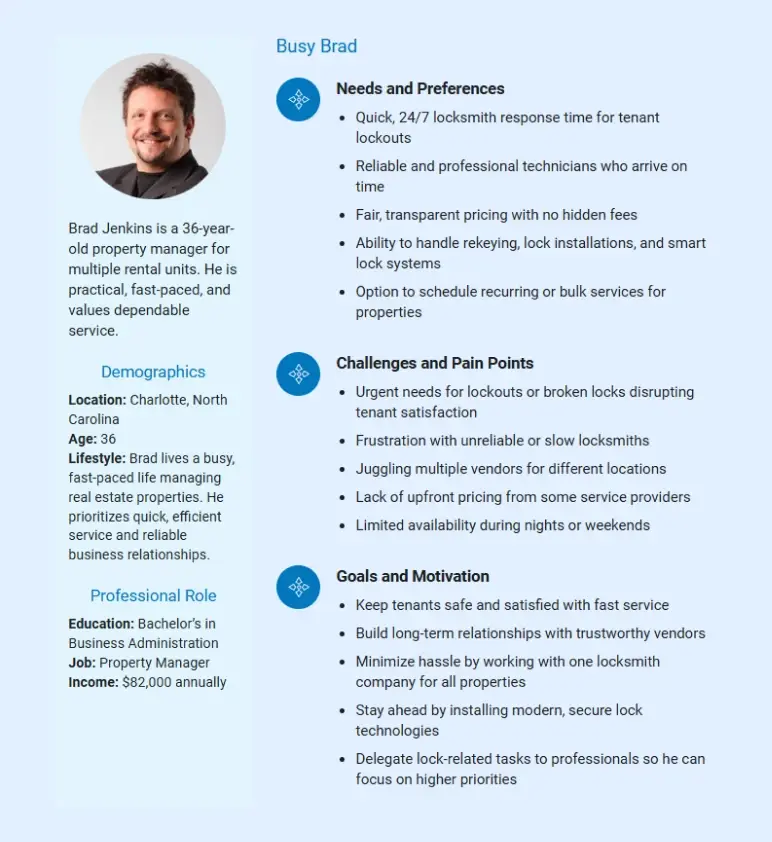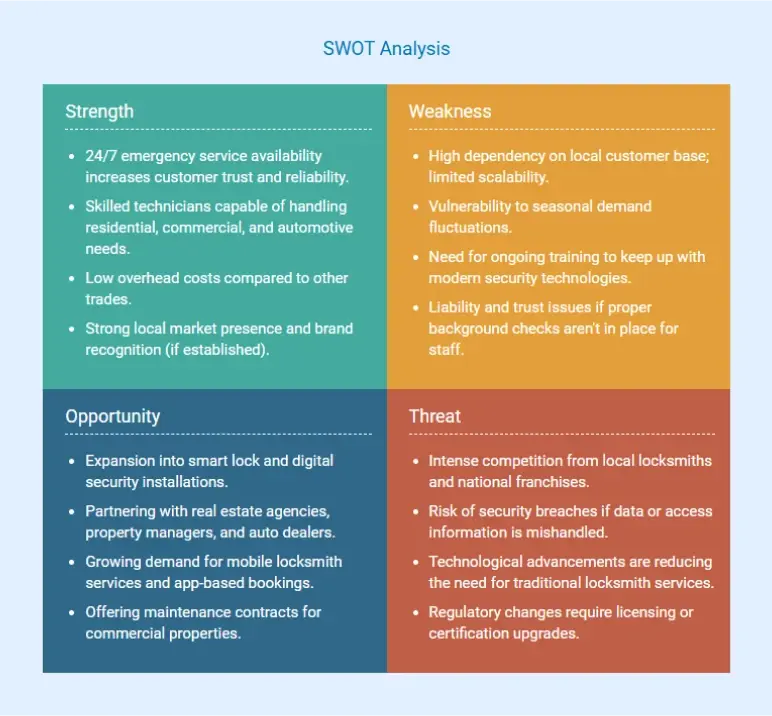Thinking about starting a locksmith business?
Smart choice: It’s a hands-on service that solves real problems—from emergency lockouts to home security upgrades. But there’s more to it than just having the right tools.
You’ll need a solid plan that lays out how you’ll offer services, handle calls, stand out, and manage finances.
But not sure how?
This locksmith business plan template will walk you through each section from your goals and strategy to financial projections, so you’re fully prepared to launch and grow your business.
What is a locksmith business plan?
A locksmith business plan is a clear, organized document that explains how your locksmith business will work. This explains your goals, services provided by you, who your customers are, how you’ll attract them, and how the business will earn and manage money.
Whether you’re running a mobile van or opening a physical shop, the scheme helps you to be focused, make smart decisions, and show others, such as lenders or investors, that your business is well thought out.
Why is a business plan important for a locksmith company?
A business plan is important for even the smallest ventures. Here’s why:
- Provides a clear path by enabling you to plan your services, perfect customers, and daily operations.
- Lets you avoid costly blunders by addressing licenses, tools, insurance, and competition upfront.
- Saves you money by identifying ways to save money by leasing expensive equipment instead of buying it.
- Shows professionalism when seeking funding or pitching investors and partners.
- Keeps you growing by identifying essential metrics and tracking your progress over time.
- Keeps your strategy current as your business grows and the market develops around you.
In other words, a locksmith business plan isn’t just a document to have on file; it’s a tool that allows you to run your business with confidence. It can save you headaches down the road and help you to achieve success from the get-go.
How to create a locksmith business plan?
Writing a locksmith business plan is much easier when you break it down into sections. Below, we’ll walk you through each key part of a solid locksmith business plan, what to include, how to approach it, and simple tips to make the process less overwhelming.
Follow these steps to build a clear, practical plan for your locksmith business.
1. Executive Summary
The executive summary is a concise overview of your entire locksmith business plan. Although it appears at the beginning of the plan, it’s usually written last, after you’ve detailed everything else.
Think of it as your business’s elevator pitch on paper. If a reader only reads this section, they should still get a clear idea of your business and its potential.
In a few short paragraphs, your executive summary should cover the high-level details of your locksmith business, including:
- Business concept
- Location & ownership
- Target market
- Unique selling proposition
- Financial highlights
- Business goals
Keep this section short and impactful, ideally one page or less. Remember, the goal is to entice the reader to continue reading the rest of your plan.
Be positive and confident, but also realistic. If someone (like an investor) reads your executive summary, they should come away with a clear understanding of what your locksmith business is and why it’ll succeed.
Say goodbye to boring templates
Build your business plan faster and easier with AI
Plans starting from $14/month

2. Company Description
The company description provides a deeper look into the foundation of your locksmith business. Here, you’ll describe who you are, what you do, and what your business setup is.
This section sets the stage for the rest of the plan by covering the following elements:
- Company overview: State your business name, the services you offer, your legal structure, and your business location (storefront or mobile).
- Mission and vision: Include a short mission that reflects your purpose and a vision that outlines your long-term goal.
- History and stage: Mention why you started the business and any early milestones or traction if already operating.
- Services and specialty: List your main services and highlight any specialty or niche offering.
- Business structure and team: Outline your company structure and mention any partners or team members.
- Goals and objectives: Share short-term goals (like breakeven timeline) and long-term goals (like expansion plans).
By the end of this section, the reader should understand your business identity, current stage, and direction. It answers: “Who’s this business and why does it exist?” clearly and confidently.
3. Market Research
Before diving into operations or financials, it’s crucial to show that you understand the locksmith market and industry.
The market research section demonstrates that there’s demand for your services and that you know the environment you’ll be operating in.
Here’s what to cover:
Industry Overview
The locksmith industry in the U.S. is a multi-billion-dollar market serving both individuals and businesses. While traditional key-cutting and lock repair remain steady, demand for smart locks and electronic security is growing. There are over 24,000 locksmith businesses nationwide, with modest 1% annual growth.
Target Market
Your customers may include:
- Homeowners and renters needing lockouts, rekeying, or lock changes
- Businesses and property managers needing high-security systems or contracts
- Automobile owners needing car lockouts or key programming
- Others, like schools or government offices, with specific security needs
Here’s an example customer persona to help visualize your target audience:

Market Need
People use locksmiths for home and auto safety, emergencies, and access to their properties.
Competitive Landscape
Are they primarily small local locksmiths or some large firms? Give a brief observation of the competition in your area.
Recent Trends and Opportunities
Smart homes can increase demand, such as the company’s systems, short-term fares, or increasing awareness about safety. Seasonal trends can affect the number of calls you receive.
Being a good market analyst makes you believe that you’re building a locksmith business on real demand rather than pure estimates.
4. Competitive Analysis
In the competitive analysis section, you’ll tell who your competitors are and how your locksmith business will stand out. Each business faces competition, and thinking about it gives you a strategic edge.
Here’s how to approach it:
- Identify the competitors in your field, including other locksmiths and hardware stores, or DIY smart lock options.
- Compare services and pricing to understand what others provide, their hours, specifics, and specific rates.
- List competitive strengths and weaknesses based on research and customer reviews (eg, rapid service but poor reviews).
- Highlight your competitive advantage, such as rapid response, smart lock expertise, better pricing, or 24/7 availability.
- Match your strengths for market intervals by focusing on the lack of competitors and where you can lead.
- Include a SWOT analysis if necessary, summarize your strengths, weaknesses, opportunities, and threats in a simple format.
Here’s a sample SWOT analysis for a locksmith business:

A well-done competitive analysis shows that you understand your market, know who you are against, and plan to win your share.
5. Product & Services Offered
This section details what exactly you’re selling your locksmith services and any related products, and how you’ll package or price them. Being clear here helps build trust with investors and customers. Let’s break it down:
Core services
List and describe your main locksmith services. Common offerings include:
| Services | Description |
|---|---|
| Portland(OR) | Boston(MA) |
| Emergency lockout services | Helping customers locked out of their home, car, or business, highlighting 24/7 availability if offered. |
| Lock installation and replacement | Installing and replacing locks, including deadbolts, smart locks, and high-security models. |
| Rekeying | Changing internal lock pins so old keys no longer work; often used by new homeowners or landlords. |
| Key cutting and duplication | Making copies of house, office, or electronic car keys. |
Additional Products
Sell any products? Mention them. This may include locks and hardware, smart locks, or small retail items like keychains. State whether products are part of a service or sold separately.
Service Packages or Bundles
Mention any bundles you plan to offer. For example, a flat-rate “New Home Package” to rekey all locks or a “Business Security Audit” that includes a site visit and discount on services. Bundles help increase your service value.
Pricing Strategy
Explain how you price your services (builds trust). Common methods include:
- Flat Fees – Standard rates for simple jobs like lockouts within city limits.
- Hourly Rates – Labor plus cost of parts, often used for larger jobs.
- Tiered Pricing – Higher fees for late-night or emergency calls.
By clearly outlining your services and pricing, you show you’ve built a realistic, thought-out plan for generating revenue and serving customers well.
6. Marketing and Sales Strategy
You need customers to know about you to make money! This section explains how you’ll attract and retain customers. Here’s what to include:
In a few short paragraphs, your marketing and sales strategy should cover:
- Branding and how you position your business (e.g., fast 24/7 service, affordable local expert, or high-tech specialist)
- Online presence, including a professional website, SEO, and social media like Facebook or Nextdoor
- Local advertising through Google Ads, flyers, newspapers, or vehicle branding
- Networking with realtors, property managers, and community groups to generate steady referrals
- Promotions like discounts for new customers or referral rewards to boost early traction
- A clear sales process from first contact to follow-up, with mention of call handling, estimates, and review requests
Your marketing and sales strategy doesn’t need to be elaborate, but it should be practical and targeted. Focus on the channels that make sense for a local service business.
7. Operations Plan
The operation plan explains how your locksmith business will run daily. This indicates that you are ready to distribute the services efficiently and firmly. What’s included here:3
| Operations plan element | Description |
|---|---|
| Business location & service area | State whether you operate from a shop, a mobile van, or both. List the cities or neighborhoods you will serve. |
| Hours of operation | Share your standard business hours. Mention if you offer 24/7 emergency services or have specific appointment times. |
| Equipment and Tools | List key tools like cutting machines, rekeying kits, and service vehicles. Note any plans for advanced equipment. |
| Supply Chain & Inventory Management | Mention where you’ll source locks and key supplies, how you’ll manage stock, and your typical restocking process. |
| Staffing and Team Roles | If starting solo, say so. List future roles you may hire for, like technician, assistant, or dispatcher. |
| Licenses, Permits, and Insurance | Confirm that you’ll meet legal requirements like locksmith licenses, registration, insurance, and bonding. |
Overall, the operations plan should convince the reader that you have a practical system in place to run the business smoothly. It’s about translating the business idea into action.
A well-thought-out operations section demonstrates that once customers start calling, you can deliver services efficiently, maintain quality, and handle the day-to-day mechanics of the business smoothly.
8. Management Team
Even if you’re starting as a one-individual operation, the management team section is important to establish who’s running the show and why they are capable.
Investors and lenders give a lot of weight to the people behind a business. In this section, you will introduce yourself and any major team members or advisors, highlighting relevant experiences and roles.
- Founder/owner: Provide a small bio that highlights your locksmith experience, any certificates, and relevant skills. Explain your day-to-day role in operation, service distribution, and overall management.
- Team members: List any additional locksmiths, technicians, or supporting staff, and mention their roles and relevant backgrounds.
- Partner: If you have a co-owner or partner, describe their responsibilities and how to divide duties between you.
- Structure and reporting: Explain the reporting structure of your business, even if you are single, and how responsibilities are held.
Here’s an example of an organizational structure for a small locksmith business:

- Advisors and mentors: Include any business or industry consultant offering guidance, and briefly mention their experience.
- Hiring Plan: To expand your team, mention any plan, such as hiring and hiring each other locksmith or an office assistant.
By the end of the management team section, the reader must realize that the people running this locksmith business are reliable, knowledgeable, and ready to execute the plan effectively.
9. Financial Projections
The financial projections section is where you show how your locksmith business will perform financially over the next few years. This part gives readers a clear picture of the startup costs, operating expenses, revenue streams, and expected profitability.
Even if you’re not a math person, it’s crucial to present realistic figures to support your plan. Let’s break down what to include:
In a few short paragraphs, your financial projections should cover:
- Startup costs, including tools, a locksmith van, inventory, licenses, insurance, and early marketing
- Revenue estimates, such as income from service calls, product sales, and long-term contracts
- Monthly expenses, like fuel, inventory restock, insurance, marketing, phone, and software
- Profit projections for at least 3 years, with assumptions around growth and break-even timing
- Cash flow approach, showing how you’ll handle payments, invoicing, and emergency reserves
- Funding needs, including how much you’re requesting and exactly how it’ll be used
Briefly explain your cash flow approach and, if seeking funding, state how much you need and how you’ll use it.
This section doesn’t need to be complex, but it should show that your financial plan is solid and your business has real potential to succeed.
Download a free locksmith business plan template
Ready to create your own locksmith business plan but need a little extra help? We’ve got you covered. Download our free locksmith business plan template (PDF) to jumpstart your planning.
This template comes pre-filled with example content and a detailed outline for all sections, making it easy to customize for your business. It saves you time and ensures you don’t miss any key details, giving you a solid starting point to build your plan with confidence.
The Quickest Way to turn a Business Idea into a Business Plan
Fill-in-the-blanks and automatic financials make it easy.
Conclusion
Let’s wrap it up! We’ve covered all the key sections of a locksmith business plan and how to write each one. Plus, we’ve broken it down into simple steps to make the process easier. Now, you should feel more confident drafting your locksmith business plan.
Still feeling stuck or want to speed things up? Tools like Upmetrics can make a big difference. With AI-powered guidance, built-in financial forecasting, ready-to-use templates, and helpful resources, it’s a faster, easier way to build a complete, professional business plan that works.



